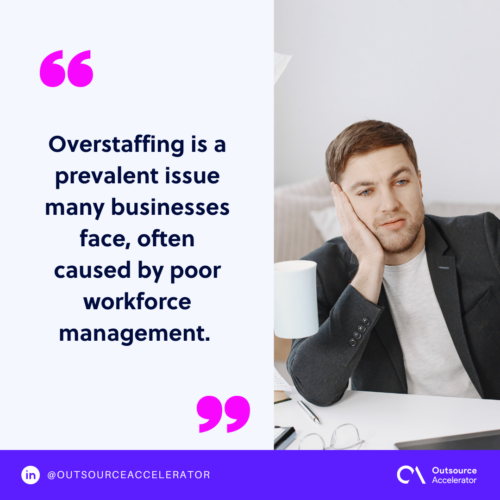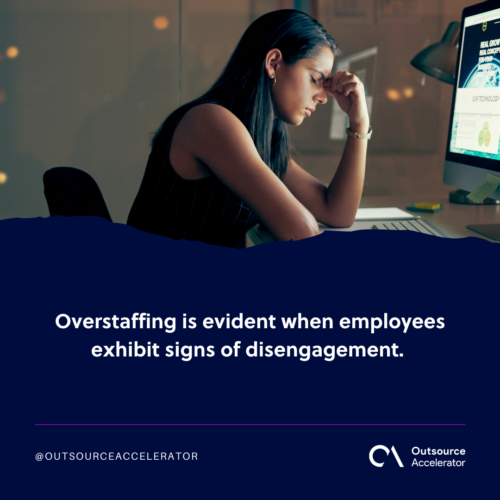Cracking the code of overstaffing: Mastering workforce management

Workforce management is an essential aspect of running an organization successfully. It’s crucial to balance the right amount of staff with the right skills and experience.
However, finding the right balance can be challenging. As a result, many companies struggle with overstaffing. It occurs when a business has more employees than it needs to operate effectively.
In this article, we’ll delve more into what overstaffing is, the issues it presents, how it impacts organizations, including some of the ways to identify and handle it.
Overstaffing: An overview
Overstaffing is a prevalent issue many businesses face, often caused by poor workforce management. It occurs when a company has more employees than it needs to carry out its operations efficiently.
Overstaffing can have a range of negative consequences for an enterprise. And it can lead to a lack of focus on core business activities and a loss of competitive advantage.

What happens when a company is overstaffed?
When a company is burdened with excess workers, several issues can arise. These issues negatively impact the company as a whole.
Below are some of the most common problems caused by overstaffing:
Increased employee turnover
According to CNBC, 50.6 million workers in the US quit their jobs in 2022.
Overstaffing contributes to employee turnover, as talented individuals may seek better opportunities elsewhere. It causes workers to feel undervalued or have limited growth prospects.
Difficulty in decision-making and communication
With too many employees, decision-making and communication can become more challenging and slower. This would hinder effective collaboration and the timely execution of tasks.
Wasted resources and missed opportunities
Overstaffing wastes resources, such as salaries, benefits, and office space. It can also lead to missed opportunities as the company may be unable to focus on strategic initiatives due to a surplus of workers.
Negative impact on organizational culture
When a firm is overstaffed, it can create an environment where workers may feel undervalued. This can cause low morale, decreased motivation, and a decline in overall employee satisfaction.
Increased overhead costs
Overstaffing leads to increased overhead costs. The company has to bear the expenses for a surplus of employees.
Underutilized staff
Excess staff often results in more idle time and workers not being fully utilized. This leads to the staff wasting their talents and skills.
Decreased productivity
Having more than-needed employees causes a lack of sufficient tasks or responsibilities. They may strugggle to stay engaged and perform at their best.
Layoffs
In severe cases of overstaffing, companies may need to resort to layoffs to align their workforce with business needs. This results in job losses and potential negative impacts on remaining employees.
Dissatisfied clients
Overstaffing can impact the quality and timeliness of deliverables. This leads to unhappy clients who may experience delays, reduced attention, or subpar service.
Signs of overstaffing
To effectively address overstaffing, it is crucial to recognize the signs and symptoms early on. Here are some indicators that a company may be facing overstaffing issues:
Underused employees
One sign you’re overstaffed is when some or most of your workers consistently have idle time or lack meaningful tasks. It ends up wasting everyone’s time, effort, and resources.
Increased operational costs
Another sign of overstaffing is when there’s a rise in expenses without proportional revenue growth. Specifically, if it’s related to payroll and benefits.
Low productivity and efficiency
If you notice tasks take too long to complete despite having an ample workforce, you might be overstaffed. It also shows when the quality of work is not up to standard, even if you have enough qualified workers.
Lack of employee engagement
Overstaffing is evident when employees exhibit signs of disengagement. It can result in reduced motivation, decreased job satisfaction, and limited interest in their work. As a result, the work they’ve put out may be of low quality.
Difficulty allocating resources
Your business is probably overstaffed if managers struggle to distribute work effectively. Especially, if they face challenges ensuring that each employee’s skills are fully utilized.

Dealing with overstaffing issues
Overcoming overstaffing requires a strategic and systematic approach. Outlined below are steps to help you effectively manage and mitigate this issue
Conduct a workforce analysis
Perform a thorough assessment of the current workforce to identify inefficiencies or redundancies. Analyze workloads, skills, and roles to determine the optimal number of employees required for each department or team.
Implement workforce planning
Develop a robust workforce planning strategy to align the organization’s staffing needs with its business goals. This involves forecasting future requirements and considering seasonality, growth projections, and market trends.
Optimize workflows and processes
Streamline workflows and processes to maximize efficiency and eliminate unnecessary steps or redundancies. By optimizing operations, the company can accomplish more with fewer resources. Therefore, it reduces the need for over-hiring.
Invest in employee development
Instead of hiring new employees, focus on upskilling and cross-training existing staff members.
This enables workers to take on additional responsibilities and broaden their skill sets. It would increase productivity and reduce the need for additional hires.
Establish performance metrics
Define clear performance metrics and KPIs for each role and department. Regularly monitor and assess employee performance against these metrics to ensure optimal resource use and identify improvement areas.
Implement flexibility measures
Consider implementing flexible work arrangements. Flexible schedules and remote work options can help balance workload fluctuations.
This type of work arrangement enables workers to achieve a better work-life balance. With a satisfied workforce, there’s a high chance of outstanding performances and outputs.







 Independent
Independent




